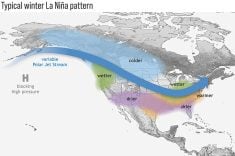Farmers in the western Prairies should take steps to prepare for and manage the effects of fusarium head blight, says a group of leading scientists in Western Canada.
The fungal disease has become the most significant cereal disease faced by farmers in Manitoba and eastern Saskatchewan, and surveys show that it is gradually working its way west.
It attacks cereal heads, resulting in yield losses and reduced grain quality. Wind-borne spores from infested crop residues infect fields and symptoms begin to appear shortly after infection.
Read Also

Canadian Food Inspection Agency extends chronic wasting disease control program consultation deadline
Date extended for consultation period of changes to CWD program
Key characteristics are bleached spikelets, underdeveloped seed and pinkish fungi on the kernels.
The scientists have issued recommendations to producers for controlling the disease’s spread. They are Kelly Turkington, of Agriculture Canada’s research centre in Lacombe, Alta.; Bob Conner of Agriculture Canada’s research centre in Lethbridge, Alta., Randy Clear of the Canadian Grain Commission, and Ieuan Evans and Lorraine Harrison of Alberta Agriculture.
They say farmers in Alberta and Saskatchewan, especially those who have not faced fusarium, need to know what they can do to minimize the chance of introducing it into their fields.
Several management strategies for fusarium have been identified:
- Don’t import the problem. Buy seed from pathogen-free infected areas, have it tested for F. graminearum, and use a suitable seed treatment.
- Avoid using fusarium infected grain as feed. The disease can be introduced when infected manure is spread onto fields.
- Producers who use infected feed should practise maximum feed efficiency to help reduce pathogen viability. Subsequent composting can further reduce the amount of pathogens. As further protection, spilled or leftover feed grain should be disposed of or buried to prevent it from acting as a disease source.
- Select a crop and a variety with a low level of susceptibility to fusarium. There are no resistant varieties available, but varieties vary in their level of susceptibility.
- Rotate crops and stagger planting times if fusarium is already present. Rotate away from cereals and corn with non-hosts such as canola, pulses and forage legumes. This
allows the infected residue to decompose before the next cereal crop is seeded. The disease is further reduced if the entire crop is not flowering at the same time, achieved by varying planting times and using varieties with different maturities.
- Producers who irrigate can reduce fusarium risk through careful water management. Wheat infections typically take place during flowering. Limiting irrigation at this time reduces humid conditions that favor infection.
- In-crop fungicide treatment may be considered, but it might only suppress the disease. Proper sprayer and nozzle settings are critical to successful application. This option will likely only be available for producers in Manitoba and eastern Saskatchewan.
- Effective harvest management is important. Adjusting combines to blow out the lighter infected kernels and chaff will improve the grade and reduce toxin levels. Practices that encourage decomposition of infected residue such as effective chopping and straw distribution should also be used.














